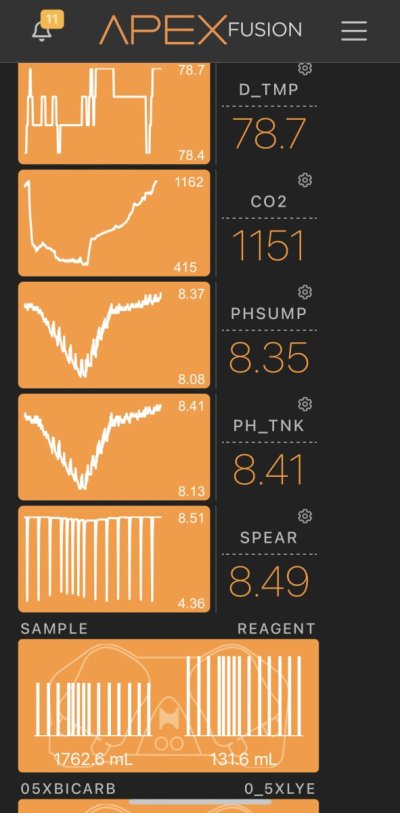Navigation
Install the app
How to install the app on iOS
Follow along with the video below to see how to install our site as a web app on your home screen.
Note: This feature may not be available in some browsers.
More options
You are using an out of date browser. It may not display this or other websites correctly.
You should upgrade or use an alternative browser.
You should upgrade or use an alternative browser.
Dispelling the myths about glass lids on reef aquariums.
- Thread starter Reefinmike
- Start date
- Tagged users None
- Joined
- Dec 28, 2016
- Messages
- 22,829
- Reaction score
- 21,963
You should consider moving this to the experimental section of R2R. @Daniel@R2RPeople in the hobby often repeat what they hear others say-
- “Glass lids Are bad. They get dirty and block a lot of light”
- “Clean glass drops PAR 10-20%. On top of that, the dirt, salt creep and humidity drops cut par an another 10-15% so you have to increase your lights every week to account for this then back to baseline when tops are cleaned”
I’ve been using glass lids for 17 years and strongly feel their benefits far outweigh the par loss most modern lighting is able to overcome.
- They prevent fish from jumping
- They limit evaporation reducing your need for topoff water- expanding the duration your ato reservoir lasts.
- They limit humidity being added to your household air
- They limit evaporative heat loss allowing you to use much smaller heaters(risk mitigation) and save a significant amount of electricity($$$)
- They protect your expensive lights from rogue fish splashing
- Most importantly- they limit the effect that high CO2 household air has on your pH. Reducing gas exchange reduces carbonic acid addition to your reef.
I did a little 1 hour real world experiment using 3 new Neptune sky lights mounted over a 72”x18”x27” 150 gallon reef with admittedly yellow foggy water(I don’t use any filtration whatsoever). The bottom of the light is 3.0” above the glass, 5.0” above the water surface and 16.5” above the par sensor(11.5” under water). The par is measured with the neptune PMK(apogee sensor). The glass is a mix of what fits. Measurements were taken under the center 3.9mm thick piece of very scratched up tempered green glass. My current lighting is set to Neptune’s custom “sky” color recipe at 66% intensity. Readings were viewed without lag using the display module. All pumps were left running as usual and the average was taken after 5 minutes. My wav pumps are on 5 second alternating pulse so flow anomalies weren’t a factor.
SKY 66% - PAR - % of Max
Dirty glass - 227 - 89.0%
Clean glass - 232 - 91.0%
No glass - 255 - 100%
Sky 100%. - PAR - % of MAX
Clean glass - 330 - 89.2%
No glass - 370 - 100%
All ch 100% - PAR - % of MAX
Clean glass - 368 - 89.8%
No glass - 410 - 100%
In conclusion, clean glass cuts PAR by 10%(on average) vs no lid at all. Dirt buildup reduces PAR an additional 2%. Using my 66% sky setting as an example- if I wanted to emulate the par with no lid I just have to bump up intensity 7% to 73%. Glass lids work.
I believe this squashes the misconceptions surrounding PAR reduction however it does not address the potential shift in color spectrum. I’ll leave that up to someone who really wants to nit pick lass works for me. In another, much more thorough experiment I will address the pH “boosting”, topoff reducing and electric(heat) saving benefits of glass lids.
Image description
1- shows the amount of dirt allowed to accumulate on lids over 6 weeks
2- shows the general hazyness to the water. And wild coral growth provided glass lids don’t hold you back
3- par sensor location
4- shows the basicness of the setup. Random glass lids, hastily made light rack resting on two stacks of buckets- real world testing.
5- This is the center glass that readings were taken under. This is it CLEAN. Very hazy, scratched, hard water deposits
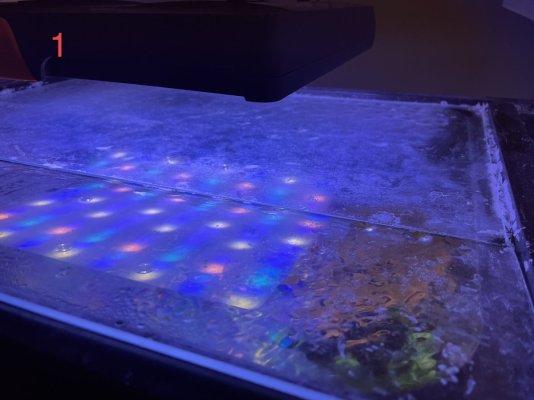
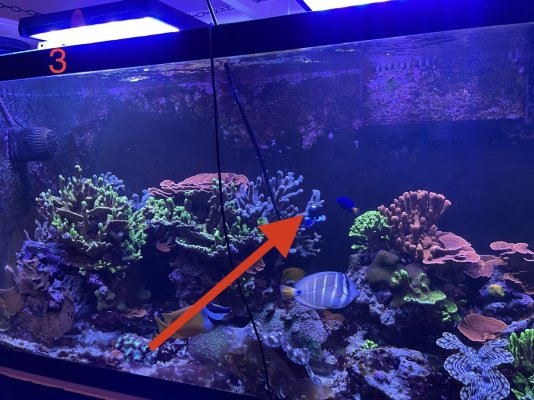
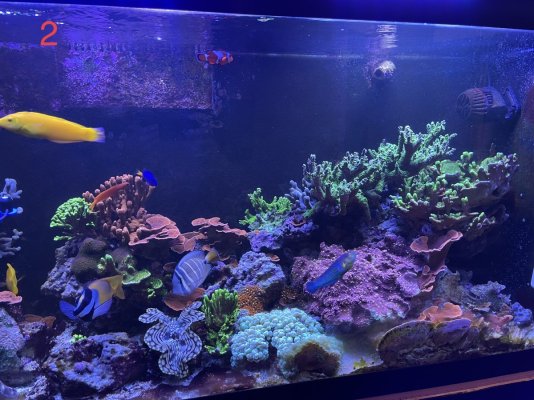
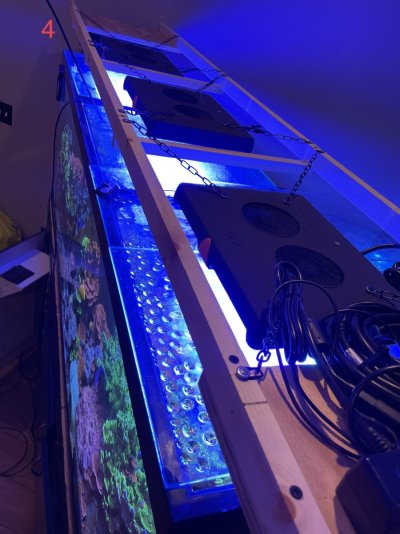
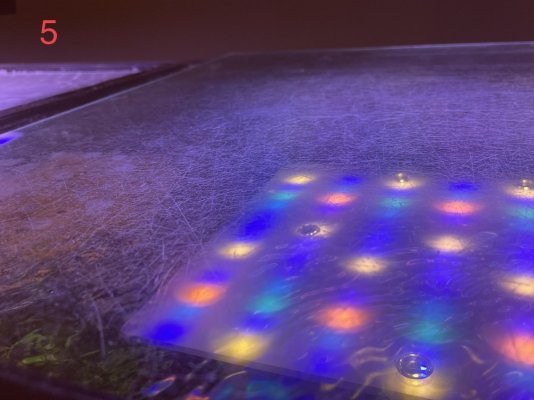
- Joined
- Dec 28, 2016
- Messages
- 22,829
- Reaction score
- 21,963
It would be my opinion (I haven't done the experiment) - that most of the light loss is due to reflection from the glass itself. I would suggest a couple things - 1. Do not measure PAR with only 1 light setting (i.e. some may be more reflected than others)Very interesting. I never would’ve thought polycarbonate could have that much of an effect.
Some window glasses have light filtering films to limit UV and heat energy entering a building. I wouldn’t be surprised if some plastics intended for windows have similar properties.
2. Measure it at different levels of the water.
3. Measure it with different coverings/types of glass.
I'm trying to figure out how only a 10% difference of PAR is resulting - and my GUESS is that it relates to where you're doing your measurements. IMHO - perhaps your conclusion should be - with the thickness of glass that I used - of the type I used - there was a 10% reduction
Also curious did you have much data on pH with the lid and without?
Okay, I'll bite. Describe some of the things you notice by the smell!True, once you owned a reef tank for more than a year, you can tell what is going on in the tank by the smell
One time I noticed the skimmer liquid was very "algae-y" smelling but that is the only time an odor caught my attention. The tank had a nightmare case of hair algae.
I'll never not use a tight fitting lid for all of my aquariums. I prefer the polycarbonate panels for greenhouses to make a lid out of.
- Joined
- Sep 13, 2018
- Messages
- 360
- Reaction score
- 333
No, it means that I recognize their cons- (par drop, PITA to clean) are easily negated by the list of pros I rattled off.But in your last paragraph you said "I feel their negative aspects far outweigh their benefits" so...this means you use glass lids even though there are mostly negative aspects?
You're correct, my mistake... As others have already pointed out, CO2 is produced when photosynthesis stops.COv2 is not produced by photosynthesis, O^2 is.
Tell me about itWhat if your sense of smell is not good. I guess then you would have to taste your water
If everything look good in the tank, a pleasant ocean like smell. If something not doing well or dying, rotten egg smell. After feeding, another kind of smell that will last for about an hr to remind me I did feed the fish. After trimming the macro alage in the sump, another present smell that will last for couple hours. If I forgot to turn the UV backup on after dosing amino acid, another smell..... After W/C another smell....Okay, I'll bite. Describe some of the things you notice by the smell!
One time I noticed the skimmer liquid was very "algae-y" smelling but that is the only time an odor caught my attention. The tank had a nightmare case of hair algae.
I have often wondered about this myself. I have a 30 gallon IM cube with a glass top over the main chamber, but the back is open to the air. I have an evaporation rate of about 1 liter every 3 days. As I tried to switch to kalkwasser as makeup water my evaporation was not enough for that to even come close to keeping up with calcium and alkalinity requirements!I’d also add that for folks like myself who used kalkwasser, evaporation can be a plus, not a negative.
it also helps cool the aquarium in hot weather, if that is a concern.
I run a gen 5 XR15 Blue light, and I have a chiller on the tank because it is in my sunroom which can get quite hot. The temp stays around 75 to 77 degrees with the chiller. I have more than enough horsepower on the light for that tank and I run it at 65% of full power.
The most interesting thing in my case though is that I do not get any condensation on the glass at all, and it is only about 1.5" above the water's surface. My glass top is not a tight fit though. It has less than 1/8" gap around the sides and front, barely enough room to put a flat power cord through the gap. If I slide it all the way to one side the gap is about 1/4" and I have had a yellow coris wrasse find that gap twice. The second time I was not there to put him back!
I say all that to say this. Perhaps the small gap around the edge helps to reduce the amount of condensation on the glass and thus reduce salt creep. Literally, nothing gets on my top glass unless I put something on it.
I am glad to read this thread. I was considering removing the top to see if the additional evaporation would cause faster evaporation and thus have a higher impact on Calcium and Alkalinity with the higher makeup water demand. Now that I am dosing calcium and alkalinity, I think I will leave it alone and prevent my other fish from jumping out! Now if I could just find a way to reduce the stray light I would be happier!
- Joined
- Dec 28, 2016
- Messages
- 22,829
- Reaction score
- 21,963
The tank should smell like nothing. IME. To the OP - there are numerous well documented negatives to a glass lid. And some potential positives. Glad your lid is working!!!!!!If everything look good in the tank, a pleasant ocean like smell. If something not doing well or dying, rotten egg smell. After feeding, another kind of smell that will last for about an hr to remind me I did feed the fish. After trimming the macro alage in the sump, another present smell that will last for couple hours. If I forgot to turn the UV backup on after dosing amino acid, another smell..... After W/C another smell....
One important smell I forgot to mention. I did carbon dosing. I love that sweet smell coming out from the waterThe tank should smell like nothing. IME. To the OP - there are numerous well documented negatives to a glass lid. And some potential positives. Glad your lid is working!!!!!!
- Joined
- Feb 19, 2020
- Messages
- 671
- Reaction score
- 353
Gas exchange happens at my overflow's weir, I figure. With or without a glass lid. Skimmer might add some, but this is hotly disputed, as I understand it. For starters, all tank water has its surface tension broken several times per hour when it goes over the weir, but not all tank water is going thru the skimmer.
I don't get the whole surface agitation obsession. It seems to me it just misdirects flow away from coral, or involves restricting flow your returns need to push through, and it increases evaporation which you may want if you live in a hot climate, but otherwise, is not net positive. Looking down into the tank is also a cool view, obscured if your surface is agitated.
I don't get the whole surface agitation obsession. It seems to me it just misdirects flow away from coral, or involves restricting flow your returns need to push through, and it increases evaporation which you may want if you live in a hot climate, but otherwise, is not net positive. Looking down into the tank is also a cool view, obscured if your surface is agitated.
Daniel@R2R
Living the Reef Life
View Badges
Staff member
Super Moderator
Reef Squad
Partner Member 2024
Excellence Award
Photo of the Month
Article Contributor
Hospitality Award
Article Administrator
Reef Pumpkin Carver
R2R Secret Santa 2023
My Tank Thread
This is a really interesting discussion. I prefer mesh lids for my tank, but some of the common ideas in the hobby should be routinely challenged. Even if they're right, it's good to be reminded of why. I'm also enjoying the conversation around other parts of this like the comments on surface agitation and gas exchange.
- Joined
- Apr 29, 2020
- Messages
- 74
- Reaction score
- 46
Why do you believe that you have a "high ambient CO2 level" in your house?Absolutely.
I’m not talking about wrapping the tank and sump air tight with saran wrap level of reduced gas exchange- that will likely kill fish from oxygen deprivation.
I like to suggest passive minimization of gas exchange- full fitting glass lids with just a 1/3-1/2” gap at the rear for wires and a little bit of fresh air. Keep decent surface agitation with powerheads as you normally would. Avoid fans blowing air across this gap. The sump doesn’t need sealed in any special way either. Just use some timer or apex with osc code to keep ventilation fans running a minimal amount to prevent problems from humidity buildup.
In the fight against pH depression, high ambient CO2 levels are inarguably the cause of the issue. Maximizing surface agitation on an open top tank with a fan blowing over it will maximize carbonic acid in your reef leading to the lowest pH possible. Limiting the available CO2 limits pH depression
Randy Holmes-Farley
Reef Chemist
View Badges
Staff member
Super Moderator
Excellence Award
Expert Contributor
Article Contributor
R2R Research
My Tank Thread
- Joined
- Sep 5, 2014
- Messages
- 67,311
- Reaction score
- 63,661
I am confused by this statement, and am not convinced it reflects the gas exchange process well.For starters, all tank water has its surface tension broken several times per hour when it goes over the weir, but not all tank water is going thru the skimmer.
As a technical point, not all tank water goes over the overflow several times per hour, but neither does it go through a skimmer.
Gas exchange is a slow process and can be limited both by the amount of clean gas water interfacial area, and the movement of gas to that surface from deeper in the water.
I’m not sure how I see a typical overflow is better than a skimmer from an aeration standpoint. I’d expect a skimmer to be far better, and might also expect the tank top interface to be better unless it is coated with organics since the surface areas are likely to be higher in both than in most overflows.
On another technical point, water going down my overflows were not getting a lot of fresh air from outside the tank system. If I had a glass top on the tank, it would be seeing the same, potentially stale air that the tank top was seeing, while my skimmer was getting fresher air from outside the system.
- Joined
- Sep 13, 2018
- Messages
- 360
- Reaction score
- 333
Because any house with people breathing inside will have CO2 levels higher than outside. And because I have a telaire ventostat CO2 meter hooked to my apex. You can see when I went from windows open(415ppm) to closed…Why do you believe that you have a "high ambient CO2 level" in your house?
Attachments
I agree with this. Before I had open rimless Elos 90 gallon. I struggled to keep pH above 8.08Absolutely.
I’m not talking about wrapping the tank and sump air tight with saran wrap level of reduced gas exchange- that will likely kill fish from oxygen deprivation.
I like to suggest passive minimization of gas exchange- full fitting glass lids with just a 1/3-1/2” gap at the rear for wires and a little bit of fresh air. Keep decent surface agitation with powerheads as you normally would. Avoid fans blowing air across this gap. The sump doesn’t need sealed in any special way either. Just use some timer or apex with osc code to keep ventilation fans running a minimal amount to prevent problems from humidity buildup.
In the fight against pH depression, high ambient CO2 levels are inarguably the cause of the issue. Maximizing surface agitation on an open top tank with a fan blowing over it will maximize carbonic acid in your reef leading to the lowest pH possible. Limiting the available CO2 limits pH depression
Now I have one with glass lids. And sump is RE Dreambox with lids. It has holes on lids for pickup. Holes for probes etc
Now my pH stays 8.18 at night and 8.35 during day.
I do have a big skimmer so don't forget that allows gas exchange.
I also ran a skimmer line out for air since I had a line running for waste.
In winter tanks stays warm with just one 800w heater. It's 350 Gallons water.
In summer I need to crack open lids to keep tank cooler by 2 degrees. But I see my pH drop 10 points to 8.25 during day.
So yes I didn't belive lids would help but they did. I always thought lids would limit air exchange and my pH would struggle. I was wrong. Try it.
- Joined
- Dec 28, 2016
- Messages
- 22,829
- Reaction score
- 21,963
Curious - on a scientific basis, how would having a lid on the tank keep your pH up - if you're pumping the same air in the house through the skimmer>? There shouldn't be any difference between gas exchange from the skimmer - as compared to not having a lid? (Unless you're using some CO2 reducing intake on the skimmer)I agree with this. Before I had open rimless Elos 90 gallon. I struggled to keep pH above 8.08
Now I have one with glass lids. And sump is RE Dreambox with lids. It has holes on lids for pickup. Holes for probes etc
Now my pH stays 8.18 at night and 8.35 during day.
I do have a big skimmer so don't forget that allows gas exchange.
I also ran a skimmer line out for air since I had a line running for waste.
In winter tanks stays warm with just one 800w heater. It's 350 Gallons water.
In summer I need to crack open lids to keep tank cooler by 2 degrees. But I see my pH drop 10 points to 8.25 during day.
So yes I didn't belive lids would help but they did. I always thought lids would limit air exchange and my pH would struggle. I was wrong. Try it.
Similar threads
- Poll
- Replies
- 54
- Views
- 1,731
- Replies
- 76
- Views
- 1,567
- Replies
- 2
- Views
- 152








